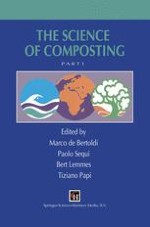1996 | OriginalPaper | Chapter
The Suppressive Effects of Composted Seperately Collected Organic Waste and Yard Waste Compost on Two Important Soilborne Plant Pathogens
Authors : C. Bruns, S. Ahlers, A. Gattinger, C. Schüler, H. Vogtmann, G. Wolf
Published in: The Science of Composting
Publisher: Springer Netherlands
Included in: Professional Book Archive
Activate our intelligent search to find suitable subject content or patents.
Select sections of text to find matching patents with Artificial Intelligence. powered by
Select sections of text to find additional relevant content using AI-assisted search. powered by
Each year during the period 1991 to 1994, three different types of input material (yard waste, biowaste and cattle manure) were composted and subsequently evaluated for their suppressiveness towards Pythium ultimum and Phytophtora parasitica spp.. This was achieved by means of bioassays conducted in a sterilised substratum (sand) employing the host-pathogen systems peas – P. ultimum and in non-sterilised substratum (commercial peat based potting mix) applying the host-pathogen systems peas or cucumber – P. ultimum and tomato – P. parasitica nicotianae. Amendment of P. ultimum inoculated sterilised sand with yard waste- and biowaste compost resulted in a significantly increased yield (fm). This was mainly due to pathogen suppressive biological mechanisms induced by compost. Composted cattle manure showed such an effect only occasionally. In experiments where 90% of control treatment plants were damped off, compost addition, apart from cattle manure compost, resulted in a reduction of the disease incidence by 30 to 50%. In bioassays with soils naturally infected with root-rot pathogens of red beet, however, we also observed some suppressive effects of cattle manure compost.Contrary to cattle manure compost, both yard waste- and biowaste compost show a high level of specific microbial activity, i.e. a high rate of Fluorescein diacetate-hydrolysis per unit microbial biomass. Therefore, micro-organisms originating from both waste composts are better competitors for easily available carbon sources. This results in a fungistatic effect towards pathogens since these organisms depend on the same carbon sources. This has been shown by the suppressive effects towards P. ultimum of a 50% yard waste compost amendment of a peat growing media in comparison to non-amended pure peat growing media. The two waste composts have been evaluated in non-sterilised container media in all other above mentioned host-pathogen systems. Yard waste compost application rates between 30% and 50% (v/v) resulted in a significant reduction of the disease incidence of at least 45% for cucumber, peas and also tomatoes. Due to a higher nutrient and salt content of composted biowaste, the application rate of this material was limited to 30% (v/v), resulting in a reduction of the disease incidence by 10–20%.With a St. Paulia – P.parasitica bioassay similar results were obtained during a cultivation period of 14 weeks. Compost amendment of 30 and 50% yard waste compost, respectively, to a non-sterilised peat growing media significantely prolonged the time until plants died.
